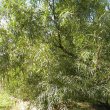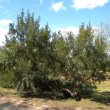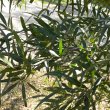Searsia lancea
| Botanical Name | Searsia lancea |
|||||||||||
| Family | Anacardiaceae - The mango family. |
|||||||||||
| Pronunciation | SEER-zee-a lan-see-uh |
|||||||||||
| Common Name(s) |
English: Karee
Afrikaans: Karee
IsiXhosa: umHlakotshane
Sesotho sa Leboa: mokalabata
Sesotho: Mosinabele
Setswana: Mosabele; Mosilabele
Tshivenda: Mushakaladza
siSwati: iNhlangutshane
|
|||||||||||
| Plant Group |
|
|||||||||||
| Plant Size |
|
|||||||||||
| Position |
|
|||||||||||
| General Information |
|
|||||||||||
| Specific Information | Searsia lancea is a low branching, usually single-stemmed, tree which has a dense, rounded, wide-spread canopy of glossy, olive-green foliage. It has a graceful, weeping form, dark, fissured bark and a contorted trunk The Karee can be used as a protective canopy for frost sensitive and shade loving plants and works well as a wind, noise or privacy barrier. The karee is of great value for difficult areas and can be planted almost anywhere, including poorly-drained or lime-rich soils. |
|||||||||||
| Ad Break | ||||||||||||
| Flowers | ||||||||||||
| Description | small, inconspicuous, in branched sprays at the ends of branches |
|||||||||||
| Season |
|
|||||||||||
| Colour |
|
|||||||||||
| Growth Rate |
|
|||||||||||
| Plant Uses |
|
|||||||||||
| Distribution and Habitat | from Zambia in the north to the Western Cape in the south, in all the provinces of South Africa except for KwaZulu-Natal, in Acacia woodland and along streams, rivers and drainage lines. |
|||||||||||
| Planting Suggestions | To encourage quick, healthy growth and a strong root system water very deeply twice a month or more, allowing the soil to dry out slightly in between waterings. Frequent shallow irrigation can result in a poorly developed root system and stunted growth. The old method of digging a deep hole and filling it with soil and compost has resulted in many trees failing to thrive, dying, rotting at the base or worse still, falling over in later years due to poor root development. Refer to the following sites for the best method of planting trees: International Society of Arboriculture: New Tree Planting Tree People: Plant the right way For those of you who have a clay problem try: Rod's Garden: Planting in clay soil
|
|||||||||||
| Medicinal Uses | The bark, twigs and leaves contain tannin. The wood is hard and was used for fence posts, tool handles, wagon parts, bowls, pipes and bows. The fruits are edible and were used as an ingredient for honey beer. |
|||||||||||
| Ad Break | ||||||||||||







Comments
Transplanting Searsia lancea
What are the effects of uprooting and transplanting Searsiaa lancea, and which season is suitable for transplanting?
Transplanting Searsia lancea
Hi Mikateko
This species has a reasonably small root system and should transplant successfully if proper precautions are taken. As you have not mentioned the size of the tree, it is difficult to give you more information. The tree should be transplanted in late autumn or late winter, before the weather warms up.
The following sites will give you information about how to transplant a tree so that it has a good chance of surviving:
http://landscaping.about.com/cs/shrubsbushes/ht/transplanting.htm
http://www.wikihow.com/Transplant-a-Young-Tree
http://www.clemson.edu/extension/hgic/plants/landscape/shrubs/hgic1055.html
Kind regards
Lorraine
Discuss this plant
Share knowledge, ask a question or give an experience.